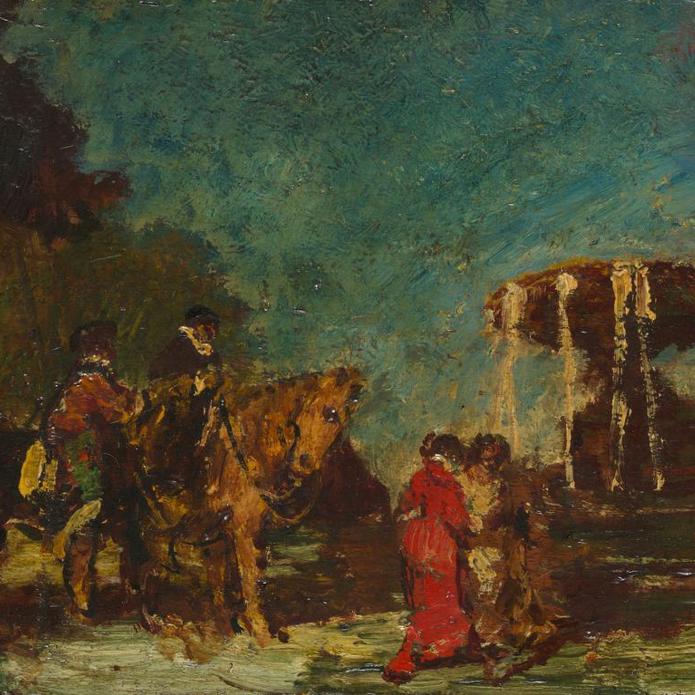Adolphe Monticelli, 'Meeting Place of the Hunt', about 1875-80
About the work
Overview
A number of grandly costumed figures are seen beside a fountain in an imaginary garden on the edge of a forest. Two men on horseback coming from the left are approaching a group of women standing in the centre but moved slightly to background. On the right, three other women and a dog are seen in front of the fountain, moving in the same direction of the horsemen.
This small panel is most probably the companion to Monticelli’s Fountain in a Park, also in the National Gallery,and both have been dated on the basis of style to about 1875–1880. In both paintings the artist evokes the eighteenth-century tradition of fêtes galantes initiated by Watteau, in which elegant figures enjoy themselves in parks and gardens.
Monticelli’s distinctive painting style, characterised by evident rapidity of execution, thick paint and blurred forms, was admired in the late nineteenth century by several artists such as Cezanne and Van Gogh.
Key facts
Details
- Full title
- Meeting Place of the Hunt
- Artist
- Adolphe Monticelli
- Artist dates
- 1824 - 1886
- Part of the series
- Two Gallant Scenes
- Date made
- about 1875-80
- Medium and support
- oil on wood
- Dimensions
- 19.1 × 47 cm
- Inscription summary
- Signed
- Acquisition credit
- Presented as part of the 'Harry Wearne Collection of Twelve Paintings by Monticelli' to the Tate Gallery, 1939; transferred, 1956
- Inventory number
- NG5012
- Location
- Not on display
- Collection
- Main Collection
Provenance
Additional information
Text extracted from the ‘Provenance’ section of the catalogue entry in Martin Davies, with additions and some revisions by Cecil Gould, ‘National Gallery Catalogues: French School: Early 19th Century, Impressionists, Post-Impressionists, etc.’, London 1970; for further information, see the full catalogue entry.
Bibliography
-
1957Martin Davies, National Gallery Catalogues: French School, 2nd edn (revised), London 1957
-
1970Davies, Martin, and Cecil Gould, National Gallery Catalogues: French School: Early 19th Century, Impressionists, Post-Impressionists etc., London 1970
-
2001
C. Baker and T. Henry, The National Gallery: Complete Illustrated Catalogue, London 2001
About this record
If you know more about this painting or have spotted an error, please contact us. Please note that exhibition histories are listed from 2009 onwards. Bibliographies may not be complete; more comprehensive information is available in the National Gallery Library.
Images
About the series: Two Gallant Scenes

Overview
In these two paintings, Fountain in a Park and Meeting Place of the Hunt, a number of figures on horseback and on foot gather beside a fountain. Their similar compositions, identical sizes and the fact that they are painted on matching wooden panels, suggest that they are companion pieces. They have both been dated on the basis of style to about 1875–80.
These imagined scenes, in which elegant figures wearing colourful dress enjoy themselves in parks and gardens, evoke eighteenth-century paintings known as fêtes galantes initiated by Jean-Antoine Watteau, a favourite subject for Monticelli throughout his career.
In his later years subject matter became subordinated to his distinctive colourful and thickly painted style. Presented as part of the ‘Harry Wearne Collection of Twelve Paintings by Monticelli’ to the Tate Gallery in 1939, these two paintings were transferred to the National Gallery in 1956.













